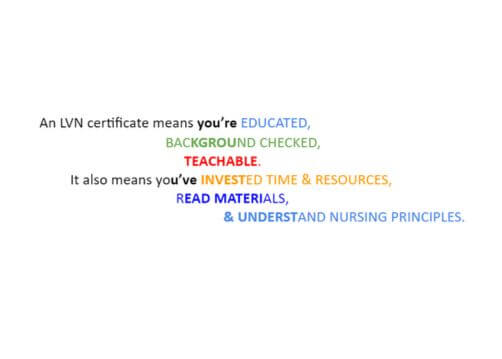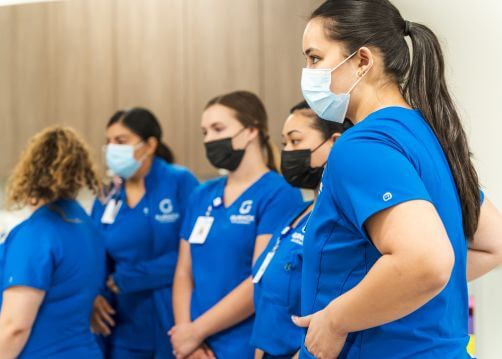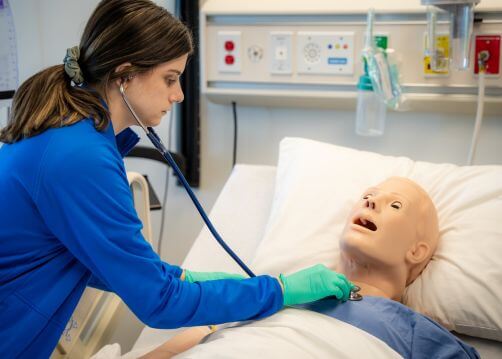General Information Regarding Vocational Nursing Programs
Date: November 9, 2023
Have you wondered what the differences are between vocational and registered nursing programs? Both are educational trajectories, right? Each program leads to a nursing career, yes? Both courses may be launching pads for higher levels of nursing—for sure. Perhaps, and most confusing, either vocation may be achieved by completing an associate degree and obtaining licensure. Wherein, then, are the core differences?
To better understand, this article takes a deep dive into vocational nursing and its program coursework.
Licensed Vocational Nurse
First, let’s define a licensed vocational nurse (LVN). In short, a vocational nurse is concerned with practical nursing and functions. An LVN provides basic medical care. While their work can vary, LVNs typically monitor patients’ health by checking their blood pressure, body temperature, and other vital signs.1 LVNs provide basic patient care and comfort, including changing bandages and helping with bathing or dressing.1 Additionally, they document patient care and maintain health records.1 On the whole, LVN tasks and scopes of practice are more limited than those of RNs. Additionally, LVNs must work under the supervision of RNs and doctors.1
Registered Nurse
On the other hand, a registered nurse (RN) is concerned with more advanced care and has a theoretical focus. Briefly speaking, RNs provide and coordinate patient care and educate patients and the public regarding various health conditions.2 By contrast, training for RNs is more extensive and includes sciences like chemistry, physiology, microbiology, psychology, anatomy, nutrition, and more. RNs must also participate in supervised clinical experience within a hospital department.3 In short, RNs have a broader scope, and their training involves more science.
Now that we’ve covered what the different roles are let’s dive into each profession’s training. What does a good VN program do?
A Good VN Program
Firstly, a good VN program equips individuals with the necessary knowledge and skills to become LVNs, not registered nurses (RNs). Secondly, a VN program leads to a VN diploma or an Associate of Science in Vocational Nursing (A.S. in VN). By contrast, an RN must hold at least an associate-level degree in registered nursing, such as the A.D.N., A.S.N., or the A.A.S. Thirdly, graduates of VN programs take the NCLEX-LVN, while RN graduates take the NCLEX-RN.
As a whole, many schools combine VN objectives into one course. However, Gurnick Academy offers VN training in two segments: the VN Diploma and the A.S. in VN. Ultimately, said diploma program is a prerequisite for entry into the VN associate degree program. After completion of the first, one may enter the other.
|
VN Diploma Program |
A.S. in VN Program |
|
13 months or 52* weeks |
8 months or 82† weeks |
|
About one (1) year |
Prerequisite diploma program + 30 weeks |
|
Serves as a prerequisite to the A.S. |
Covers GenEd courses |
VN Diploma Program Curriculum
By and large, our VN Diploma program, aka part one, familiarizes students with beginning nursing concepts. With a completion time of 13 months or fifty-two (52)* weeks, the overview encompasses the technical, clinical, and interpersonal acumen to succeed in this field. The final program module covers preparation for the National Council Licensure Examination for Practical NursesⓇ (NCLEX–PN)Ⓡ. During the course, students learn essential skills such as taking vital signs and administering medications. They also learn how to provide wound care and assist with patient care. In addition to classroom instruction, students gain practical experience through clinical rotations in real-life healthcare settings.
A.S. in VN Program
Additionally, A.S. in VN coursework, aka part two, takes roughly 30† weeks or almost (8) eight months (two semesters, with each semester being 15 weeks) to complete. Significantly, this portion adds Gen Ed courses. Moreover, program goals and objectives include knowledge of specific disease conditions in the client’s prevention treatment. Students also learn nursing care and rehabilitation. Covered are adherence to professional standards and legal and ethical responsibilities. Likewise, the Gen Ed courses are similar to those offered in the Associate Degree in Nursing (A.D.N.) Program.
Finishing both the above programs culminates in an associate degree. Upon conferment of the A.S. in VN, one may test and undergo certification as a licensed vocational nurse.
Advantages of Our VN Program
Key advantages of our VN program include:
- Accessibility. Unlike traditional four-year nursing programs, the configuration of our two-part course makes it so students do not have to take extensive prerequisites. Generally, this provides accessibility to students lacking degrees or strong backgrounds in science.
- Equipping. The program prepares graduates for work entry sooner rather than later. This allows them to gain valuable work experience and earn a steady income faster than other routes.
- Foundational. It gives a strong foundation for individuals interested in furthering their nursing education. Many LVNs enroll in bridge programs. I.e., one may wish to use the platform for other healthcare education later. Some students start their careers as VNs before pursuing higher education, such as becoming RNs.
Conclusion
In conclusion, our VN program provides individuals with fast-track options to start careers in nursing. It offers accessible training for those interested in healthcare but lacks extensive prerequisites. While the scope of practice for LVNS is more limited than that of RNs, our vocational nursing programs provide a solid foundation for further education and career advancement.
Our VN program is an excellent choice for individuals looking to enter the nursing field. Does this sound like you? If so, visit our VN program today.~
*52 Approved Instructional Weeks
†82 Approved Instructional Weeks, including technical courses taken before enrolling in the 30 weeks of general education courses.
Citations
1^a, b, c, d Bureau of Labor Statistics, U.S. Department of Labor, Occupational Outlook Handbook, Licensed Practical and Licensed Vocational Nurses. (Accessed November 7, 2023.)
2 Bureau of Labor Statistics, U.S. Department of Labor, Occupational Outlook Handbook, Registered Nurses. (Accessed November 7, 2023.)
3 “Difference between an RN and an LVN.” NurseRegistry. February 19, 2019. (Accessed November 7, 2023.)






